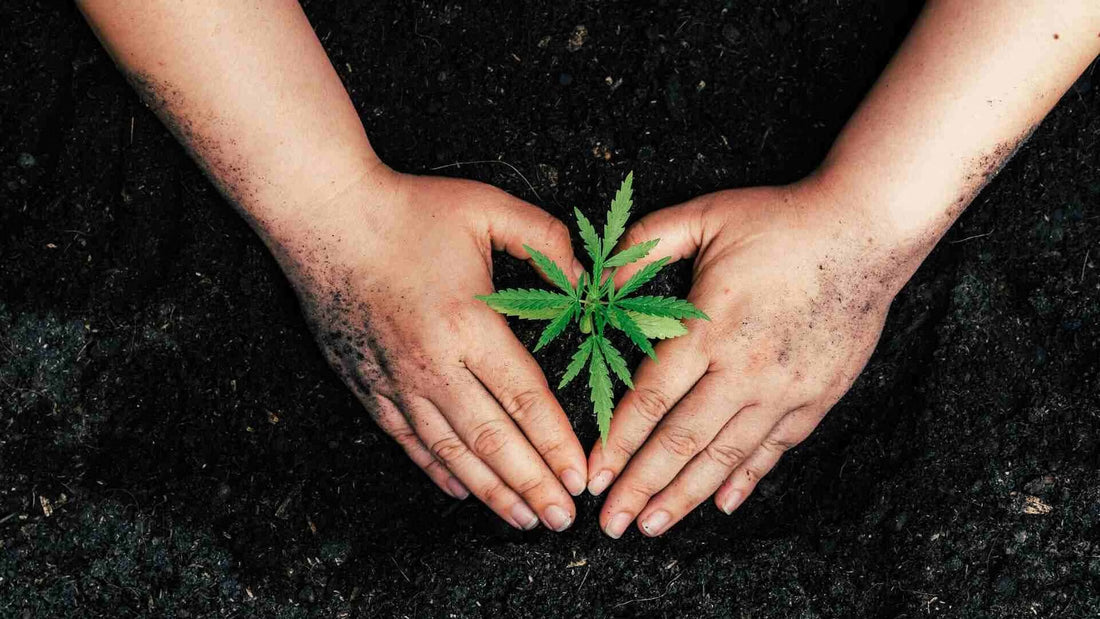
Soil And Seeding Microbes: A Healthy Living Soil Guide
Share
Outdoor gardening begins in many areas, and the time to start seeds is now. Whether you're an avid outdoor grower or this is your first season, this article will explore a few microorganisms that build healthy living soil and how we can harness them for a thriving garden.
There are various microorganisms, but we will explore bacteria, protozoa, fungi, and nematodes today. These four microbes are part of the soil food web, an intricate ecosystem that lives beneath our feet in the Earth's verdant soils. These microbes are involved with every process in the world, from making beer, cheese, and yoghurt to fighting off diseases and causing them. In our gardens, they create enzymes and acids that break down minerals into forms that are available for plants to consume. Microbes influence the world around us.
Our bodies are filled with microorganisms, including some of the same species found in our soils and keep our plants happy. Scientists have recently discovered that these same species of bacillus bacteria help our plants fend off pathogens like botrytis and cycle nutrients. They also help our bodies produce serotonin, a hormone that helps keep us happy and is produced in the gut. If that doesn't convince you to start growing outdoors using living soil, then I don't know what will.
Bacteria: Essential To Living Soil
Bacteria, like bacillus, are the smallest microorganisms found in a wide range of gardening products. They are ubiquitous in the natural world and are found everywhere, especially in compost. These tiny microbes like to eat sugar produced by plants during photosynthesis. In exchange for this sugar, they are stripped of the minerals they accumulate in the soil, known as endophytic bacteria.
Other types of bacteria consume nitrogen from freshly decaying organic matter and are consumed by other microbes like protozoa. Protozoa can consume 50% of your soil's bacterial community. This process converts nitrogen and other nutrients into plant-available forms. Some bacteria can even absorb nitrogen from the air and cycle it into the soil for plants to use. Bacteria produce slime that helps aggregate soil and dissolve minerals.
You can harness the power of bacteria in your garden by planting in the ground and using a rich and diverse compost. Certain products like this fertilizer contain a variety of microbes, including some of the bacteria known for providing nitrogen, phosphorous, and immunity defence.

Protozoa Play A Key Role In Living Soil
Protozoa are larger than bacteria and are made up of a variety of organisms such as amoeba, flagellates, and ciliates. These microbes are often overlooked in gardening products but are essential members of the soil food web. When they consume bacteria, their waste is rich in usable nitrogen.
While fewer in number than bacteria, they can be inoculated into your garden by attracting birds. They tend to live on bird's feet and move around when birds land to feed on worms and other insects in the soil. You can make your own protozoa inoculant with this recipe:
How To Protozoa Wash & Tea
1. Harvest green material from grasses early in the morning when dew is still present.
2. Fill a 5-gallon bucket 1/3 with green material.
3. Weight down with rocks.
4. Using dechlorinated water (Not RO), fill the bucket.
5. Allow to sit for 24-48 hours.
6. Strain out green material and aerate for 18 hours with:
a. 1100 mL Silica
b. ½ cup water-soluble kelp
c. ½ cup alfalfa meal or neem meal in paint strainer.

7. Add other tea ingredients:
a. 8 Tbsp Sprouted Seeds like Malted Barley in a paint strainer.
b. Aerate 12 hours.
8. Add remaining ingredients at the time of use:
a. 1 tsp Yucca Powder
b. 1 tsp Aloe Powder
c. 5 tsp Coconut Powder
Fungi: Key To Healthy Living Soil
These microbes are a unique species set that I consider the collective consciousness of the world's plants. Over 90% of plant species have a symbiotic relationship with one species of fungi or another, and these relationships span the length of forests and gardens alike, moving information from one end of the ecosystem to the next.
Fungi are slow-growing, and their delicate web of mycelium is easily disturbed. As it grows, it moves information through secondary metabolites, like terpenes, produced by plants to communicate with other plants of pests and other environmental stressors such as disease and drought. These mycelial webs can translocate water and nutrients as well.

Ensuring your plants are inoculated with the correct species of mycorrhizal fungi is essential. There are a few varieties known to create beneficial relationships with cannabis, and they are Glomus intraradices and Glomus mossea, both common species that are included in a variety of products like this one. Consider inoculating your cannabis seedlings as early as possible to get the most benefit out of this species of microbes. You can keep them happy in your garden by not tilling and covering your soil with mulch like aged woodchips or straw.
Nematodes
These worms are the largest of the four microbes discussed in this article and can consume many other organisms, including other nematodes. You can identify the type of nematode by the shape of its oesophagus and mouthparts. Most nematodes benefit our gardens by cycling nutrients through their waste and consuming pest larvae. Inoculating your garden soil with predatory nematodes that will hunt soil-dwelling pests at least once a year in the Spring can prevent many pests.
Certain nematodes are plant-parasitic and can harm your plants by feeding on their roots. French marigolds contain specific allelopathic exudates that deter parasitic nematodes and make a great companion plant.


Bacterial-Dominant Versus Fungally Dominant Soil
If you have bacterially dominant soil, you will have more bacterial-feeding nematodes; if you have fungally dominant soil, you will have more fungal-feeding nematodes.
The more established your soil ecosystem becomes, the more fungal it becomes. In the world of ecology, certain species are indicative of ecosystem successions. When there is a disturbance, bacteria are the first to move in. They begin rejuvenating soil health with their ability to sequester nitrogen from the atmosphere. Bacteria are often associated with grasslands and annual or short-living plants. In contrast, fungi thrive in developed soil food webs with minimal disturbances and are rich in woody decaying organic matter. Fungi are often associated with forests and long-living plants.

Cannabis, like many plants, enjoys a balanced ecosystem with slightly acidic soil that can come from having an equal ratio of fungi to bacteria since bacterial slime raises soil pH. You can achieve this by creating a garden ecosystem that is a suitable habitat for fungi to thrive in. The easiest way to do that is to plant in the ground and tap into the native species that are already present.
Seeding Microbes
If you grow in a container with manufactured potting mix, such as coco coir or peat moss-based, your bags will probably have been inoculated with various microbes. If you need help, you can buy products to establish your soil food web. Remember, these organisms are looking to feed on decaying organic matter, so incorporating compost and cover crops that you can cut down and allow to decompose on the soil surface is called "chop and drop," leaving your root balls to decompose, and generally not tilling or and keeping your soil surface covered will ensure your microbes are as happy and active.

Moisture is vital, and living soil does not appreciate a dry back. When soil dries out, microbes become dormant, meaning your nutrients aren't being cycled. This is important to remember when relying on organic fertilizers that require breaking down to become plant-available. Keep your microbes happy, your nutrients cycling, and your plants will thrive.
Conclusion
Living soil relies on a holistic approach to managing an ecosystem. Each organism plays its role and depends on one another to complete the cycle. This is the natural cycle of minerals, from decaying rocks and decaying organic matter to microbes and acids. We can harness the power of this natural cycle by providing a habitat suitable for microbes to flourish. This means an abundant supply of decaying organic matter and ensuring the minerals you want to be solubilized are available. You can achieve this with minimal effort by planting in the ground. When using containers, you need to continue adding compost and minerals and inoculate occasionally. With either approach, remember that moisture and diversity of decaying organic matter will ensure your microbe's cycle nutrients.

